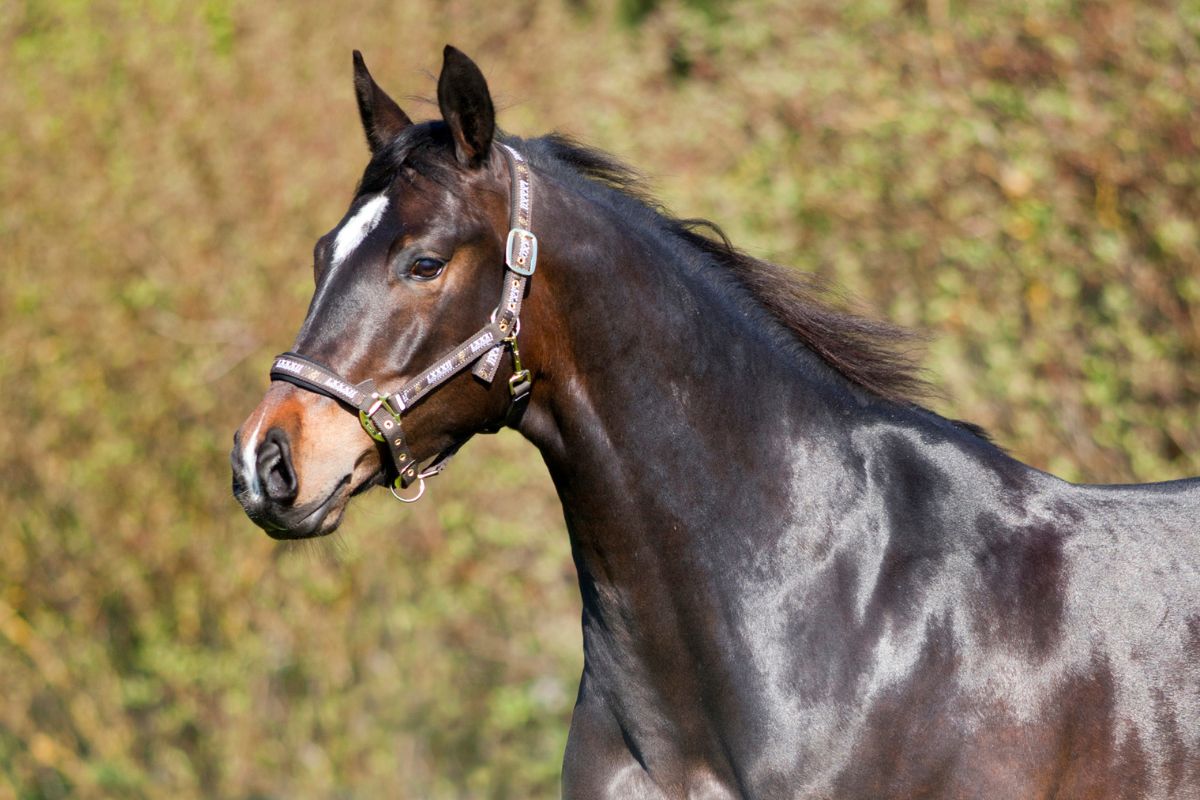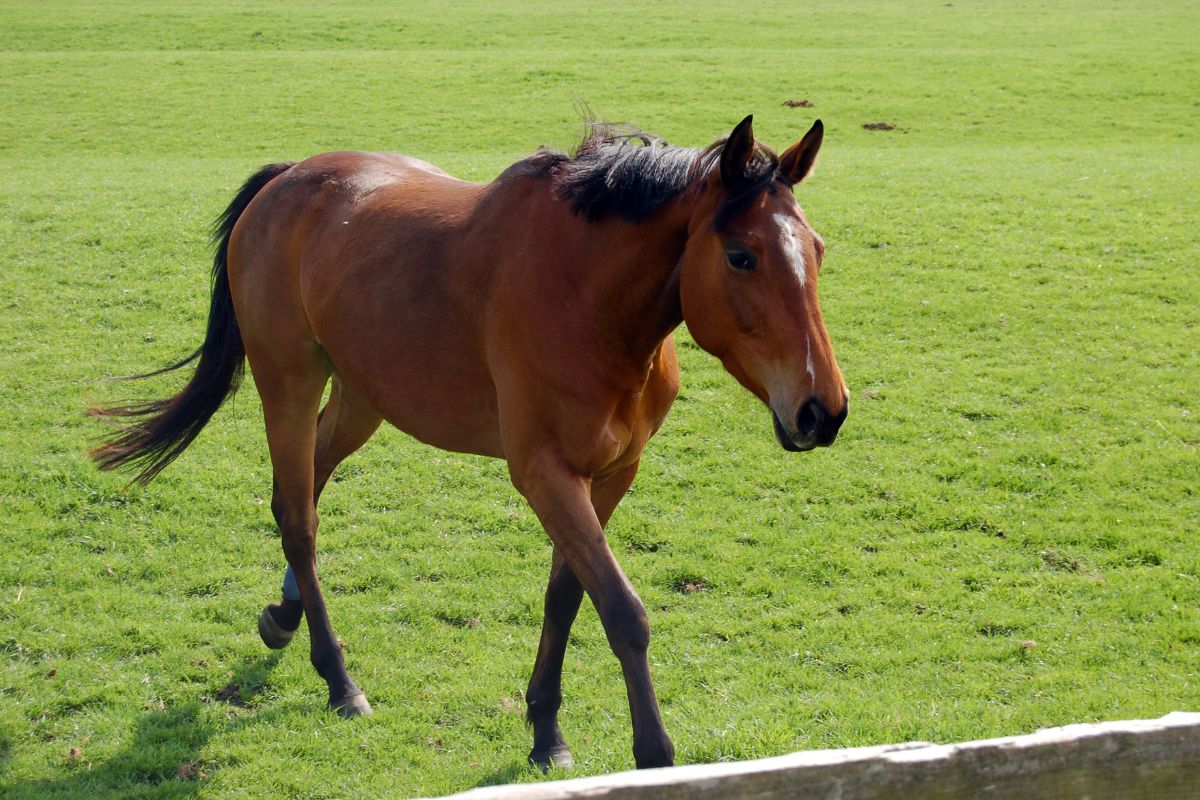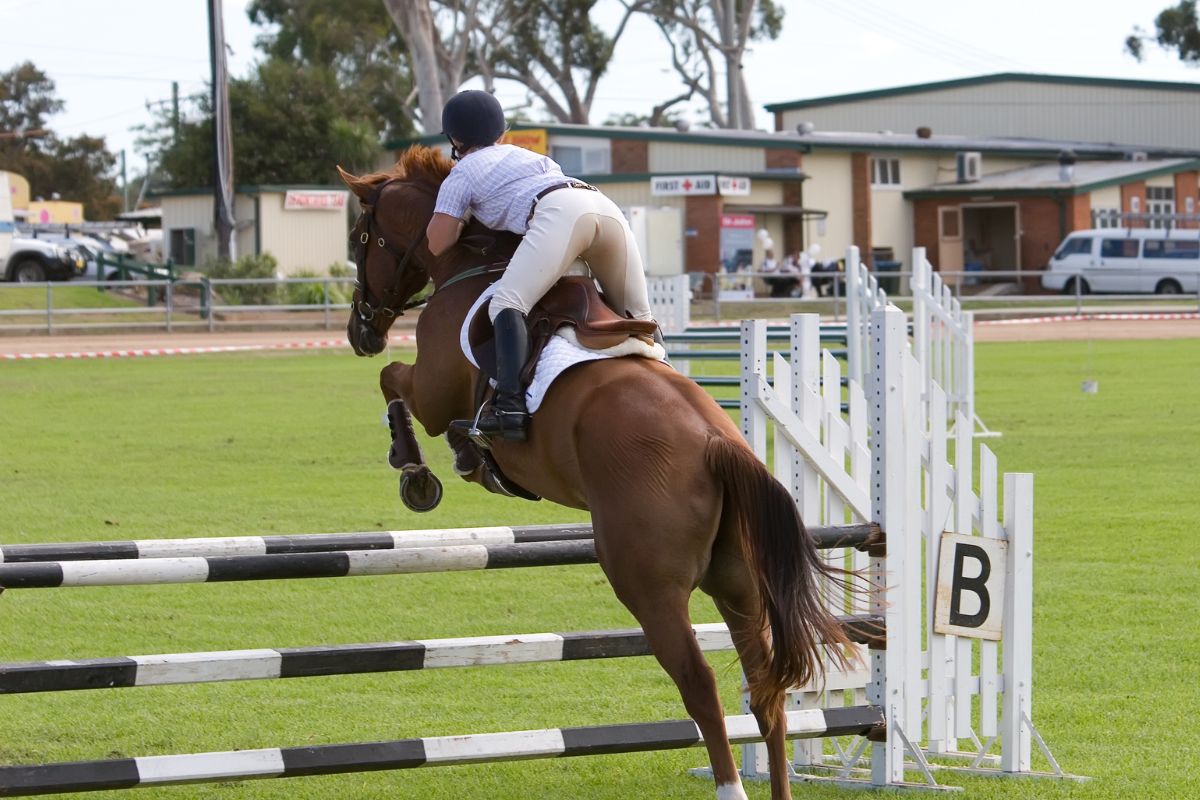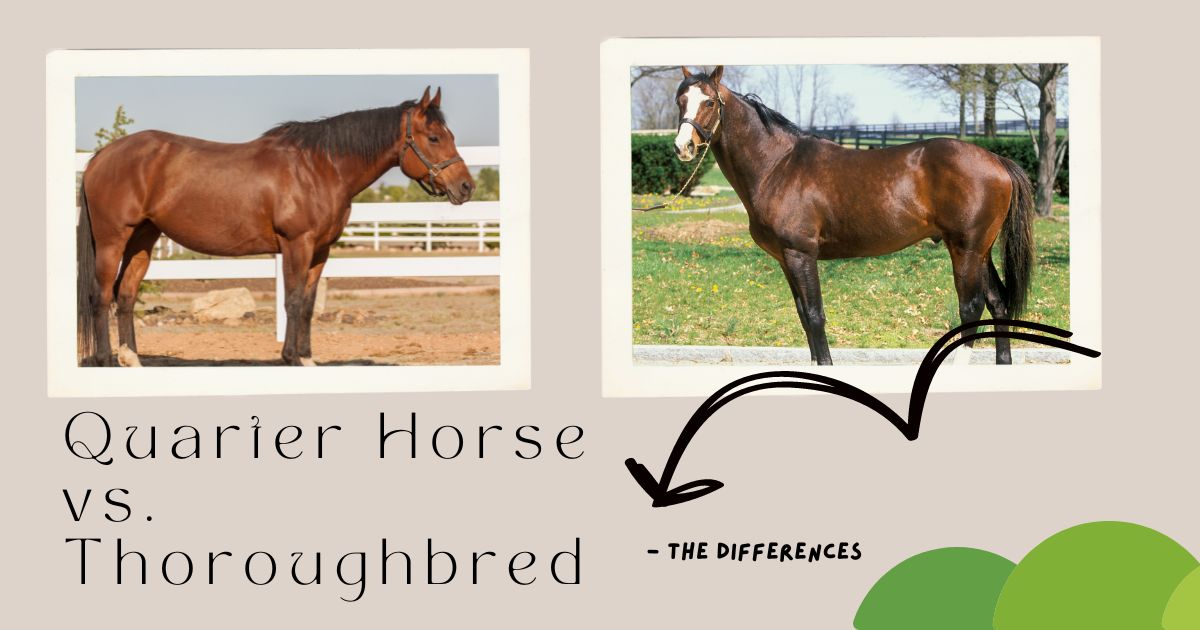The Quarter Horse vs. The Thoroughbred
It is essential for us to analyze Quarter Horse vs.Thoroughbred. Both Quarter Horses and Thoroughbreds have been among the most effective racing horses. They are ideally best for distinct types of racing situations. Quarter Horses shine when it comes to events that involve jumping and shorter distances.
Even though they serve some of the same purposes, Quarter Horses and Thoroughbreds are highly distinct from one another and attract different types of riders.
Quarter Horse vs. Thoroughbred Side by Side Comparison
| Description | Quarter Horse | Thoroughbred |
| Size | Weight: 1,000 to 1,200 pounds (453.6 to 544.3 kilograms) Height: 56 to 64 inches (142.2 to 162.6 centimeters) | Weight: 800 to 1,200 pounds (362.9 to 544.3 kilograms) Height: 62 inches to 68 inches (157.5 to 172.7 centimeters) |
| Speed | 55 mph (88.5 kph) top speed; it’s the fastest horse | 45 mph (72.4 kph) top speed, but it can maintain a high speed for longer |
| Lifespan | 25 to 35 years | 25 to 30 years |
| Body type | Muscular and stocky | Lean and athletic |
| Personality | Calm, intelligent, relatively easy to train | Intelligent, stubborn |
| Breed origins | Thoroughbred horses and Spanish horses in the U.S. | English Mares and Arabian, Barb, and Turkoman breeds import |
The Six Primary Differences Between the Breeds
The size, pace, and body type each horse possesses are the primary factors that differentiate a Quarter Horse from a Thoroughbred. Although the Quarter Horse is shorter in height, it often weighs more than its Thoroughbred counterpart.
As a result, the body shape of Quarter Horses tends to be more muscular and stockier than that of Thoroughbred horses, which are often taller and appear to have less body fat. Because these two species descended from the same ancestor, their rates of speed are comparable.
On the other hand, the American Quarter Horse can reach top speeds more quickly than a Thoroughbred can. The Thoroughbred horse, on the other hand, is superior in terms of its ability to maintain higher speeds over longer distances.
These are three of the most significant distinctions you can make between the two breeds of horse. In this section, we are going to discuss more differences between these creatures that will assist you in better conceptualizing the differences between them.
Size
The average Quarter Horse height is lower than that of a Thoroughbred, although the Quarter Horse breed weighs more overall. In addition, the Quarter Horse size can range anywhere from 1,000 to 1,200 pounds (453.6 to 544.3 kilograms), whereas the weight of a Thoroughbred can range anywhere from 800 to 1,200 pounds (362.9 to 544.3 kilograms).
The average height of a Quarter Horse is 56 to 64 inches (142.2 to 162.6 centimeters). Still, the Thoroughbred size ranges from 62 to 68 inches (157.5 to 172.7 centimeters). As a result, the Thoroughbred is a taller animal with an average weight lower than the Quarter Horse.
The Thoroughbred and the Quarter Horse are not among the largest horses in the world, even though the Thoroughbred can grow to be significantly taller than the Quarter Horse. Despite this, the disparities in size affect other parts of the horses’ bodies and the results they generate.
Speed
Let us look at the thoroughbred horse vs. quarter horse speed. How fast is a quarter horse? The Quarter Horse can reach higher speeds for longer than the Thoroughbred can. The Quarter Horse is a breed developed expressly to achieve rapid speeds over very small distances and is quite good at accomplishing that goal.
Their stocky, muscular bodies allow them to reach optimal speeds. Still, they lack the stride length and endurance to maintain this speed throughout a race. Their bodies will enable them to achieve optimal speeds. Over a relatively short distance, this breed was capable of reaching a top speed of 55 miles per hour (88.5 kilometers per hour).
On the other hand, a Thoroughbred now holds the record for the quickest speed achieved over a distance of 0.25 miles (0.4 kilometers). The maximum pace at which these horses can run is 45 miles per hour (72.4 kilometers per hour), and they can maintain that speed for a greater distance.
In addition, since Thoroughbreds have been through training for generations to achieve incredible speeds, it is safe to say that they are not sluggish horses. However, they would likely last in a short race against a Quarter Horse.
Lifespan
Between 25 and 35 years is the maximum age at which a Quarter Horse can live, but a Thoroughbred horse may live between 25 and 30 years. These horses have never been outside of a zoo or other controlled environment. Therefore their caretakers have extensive knowledge of equine breeds and the conditions that promote the best possible health in horses.
Because of this, these horses, particularly the Thoroughbred, tend to command the highest prices of any horses elsewhere in the world.
They are a massive investment, and the animals must survive as long as possible to maximize the return on that investment in terms of the number of races won the number of offspring produced, or the number of awards received in shows.
Body Type
The Thoroughbred is a sleek and athletic horse, in contrast to the stocky robust musculature of the Quarter Horse. Although the Quarter Horse is shorter than the Thoroughbred, it weighs as much as or perhaps more than the latter. The end product is a horse that is incredibly powerful but lacks the height of the world’s largest horses due to selective breeding practices.
The Thoroughbred is noticeably taller than the other horses, and its weight is even dispersion throughout its entire body. This horse appears balanced, lean and prepared to gallop.
Personality
Compared to other breeds of horses, Quarter Horses have a calm demeanor and relative ease of training. Still, Thoroughbreds are notorious for their independent spirit, which may make them challenging to instruct.
Although it is ideal to have an experienced hand oversee the development of both horses, a Thoroughbred specifically needs someone who knows how to train a horse to be by its side, or else it will be rebellious. In the majority of situations, less experienced trainers are nevertheless capable of successfully instructing a Quarter Horse.
Breed Origins
Thoroughbreds have a close relation to Quarter Horses, but the Thoroughbred originates from crossbreeding English mares with Arabian horses and other kinds of horses. Quarter Horses are primarily in use for racing.
When people from England first arrived in the New World, they discovered that the Spanish explorers who came before them brought horses to the continent of North America.
The earliest Quarter Horses were from the offspring of Thoroughbreds that made the trek to America and the “local” horses already there. There is a common ancestor between the Quarter Horse and the Thoroughbred, even though the Quarter Horse and the Thoroughbred are very different.
The Quarter Horse and the Thoroughbred are impressive animals that you should not confuse their names. They are both enormous, swift, and gorgeous. They excel in short horse races worldwide and will continue to dominate the sport to the greatest extent possible.
Both horses undergo consistent development because certain Thoroughbreds run longer distances than faster sprints. People ship Quarter Horses worldwide.
What are Quarter Horses Suitable for?
The Quarter Horse has long been one of the most popular horse breeds in the United States, particularly for racing shorter distances. As a result, they are frequently for quarter-mile events, which is how they got their name in the first place.
The Spanish horse and the English horse were the parents of the Quarter Horse, which first appeared in the United States in the 1600s. It is generally accepted that a Thoroughbred is used in England to breed Quarter Horses, suggesting a genetic connection between the two breeds.
Because Quarter Horses have a calm demeanor, many people find it simple to train them. If you are new to horse training, this is an excellent choice for your first mount. Despite this, this horse is a perfect option for specialists since they are powerful, intelligent, and excel at racing over shorter distances.
Quarter Horses are suitable for virtually all horse owners thanks to their calm disposition and ability to learn new skills quickly. While this horse is ideal for novice riders to begin their careers with, experienced equestrians can still derive pleasure from riding and competing with Quarter Horses.

What are Thoroughbreds Suitable for?
One of the most common breeds of horse used in the sport of horse racing is the Thoroughbred. This horse has a lengthy history in Britain, dating back to the 17th century. Many breed it purposefully so that it may brilliantly exhibit strength, stamina, and speed. Even though it is undeniably stunning, this horse is not the right fit for everyone.
It might be challenging to teach Thoroughbreds because of their independent and headstrong nature. You will need significant experience and self-assurance to become proficient with this breed. This is not due to the horse’s lack of intelligence. On the other hand, Thoroughbred horses are popular for their extraordinary intelligence.
They can quickly pick up instructions and cues if they have the correct trainer. Due to this feature, you should not attempt to train a Thoroughbred unless you have prior expertise and the necessary skills. It is extremely challenging for novice trainers to adequately educate a Thoroughbred horse, mainly to compete in races.
Equestrians with prior expertise are best to ride Thoroughbreds due to the horse’s independent and untamable nature. This horse is not for riders just starting because of how difficult it is to train. This might put both the rider and the horse at risk. Choose a Thoroughbred only if you have the experience and knowledge to handle one.

Which Breed is Right for Me?
Many prize the Quarter Horse and the Thoroughbred in the equine community for their stunning appearance, impressive athleticism, and overall popularity. Even though the horses may have a common ancestor and share several characteristics, they are still quite distinct from one another.
The temperament of a Quarter Horse is typically very calm and kind. Yet, they are also eager to please, hardworking, and athletic. Because of this, the breed is suitable for almost any owner. The Quarter Horse is great if you are searching for a horse to race over shorter distances. The Quarter Horse is also a great option to buy a horse for your children.
Conversely, thoroughbreds are popular for their high spirit, energy, and unpredictability. Even though they dominate the horse racing field, they are not the best horse breed for families with young children or people who are just starting in the world of horse training and don’t have much experience.
Keeping this in mind, Quarter Horses are suitable for almost everybody, except those who compete in races over long distances. If you are looking for a horse capable of running great distances, you should choose a Thoroughbred and be sure to find an experienced trainer.
The Quarter Horse is likely the more pleasurable and manageable horse of the two options for anything else you may require.
Quarter Horses Vs. Thoroughbreds FAQs
Can a Quarter Horse Beat a Thoroughbred?
Quarter Horses can win against thoroughbreds. However, this will depend on the racing event that takes place. As an illustration, a Quarter Horse may be able to win shorter races than a Thoroughbred.
They can perform well as long as they do not get off to a slow start because they have a consistent speed. If they get off to a good start, they will be able to keep that good speed throughout the game, boosting their chances of winning.
What Two Breeds Make a Quarter Horse?
The United States is the country of origin for Quarter Horses, which dates back to the 1660s. They are the offspring of native horses from Spain, including the Chickasaw horse from breeding with other Spanish horses.
How Many Breeds of Quarter Horses are There?
There are three varieties of Quarter Horses: Bulldog, Intermediate, and Thoroughbred types. The Bulldog type is the most common. The body types of Bulldogs tend to be more muscular. In contrast, the bodies of Thoroughbreds are leaner, and their legs are more elegant. In addition, the intermediate type exhibits significant increases in muscle mass.
What’s a Quarterhorse Thoroughbred Cross Called?
A hybrid offspring between a Thoroughbred and a Quarter Horse is an appendix horse. Even though they are friendly horses, their dispositions are never guaranteed. They are unpredictable, which is why inexperienced riders should avoid them.
How Much Do Quarter Horses and Thoroughbreds Cost?
Comparatively, the cost of purchasing a Thoroughbred is between $100,000 and $300,000, while the average cost of buying an American Quarter Horse is under $3000. This is why Thoroughbreds are the most expensive breed.
What is the Lifespan of Quarter Horse and Thoroughbred Horses?
It’s common for Quarter Horses to outlive their thoroughbred counterparts. In comparison, the average life expectancy of a thoroughbred is 22 to 28 years, whereas that of a Quarter Horse is 25 to 30 years. Quarter Horses tend to live longer than thoroughbreds.
Can Quarter Horses Jump?
Jumping is possible with Quarter Horses. We consider them to be the best jumpers. However, they are not great candidates for the high jump because they are muscular. If you want horses suitable for jumping at lesser levels, you should think about purchasing these horses.

We’ve Got You Covered
You now have enough information on Thoroughbred horse vs. Quarter horse. Although, at first glance, Thoroughbreds and Quarter Horses appear to be fairly similar to one another, there are significant variations between the two types of horses. These variations set them apart, not just on the racetrack but also in their mode of address and training.
Their anatomical differences confer distinct benefits, which contribute to the fact that they are among the most successful racing horses in the world. Although a Quarter Horse is popular for its ability to sprint and is an excellent choice for races that cover shorter distances, Thoroughbreds are more agile and can quickly gain speed.
This makes them perfect for those that cover longer distances, such as mile races. The differences between the Quarter Horse and the Thoroughbred are unique. One may not be able to recognize these differences until one works with horses for a significant amount of time.
